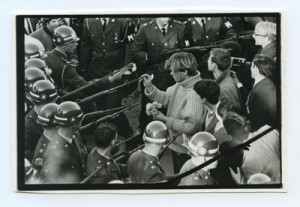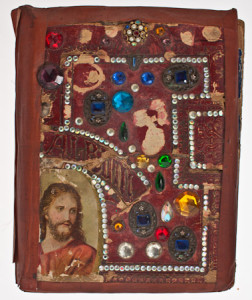Only three more performances remaining – hurry, hurry to Albuquerque before they sell out! Our cousin Dale Rose and her family caught the show this weekend and were quite moved by it. Here’s a local review:

TALKIN’ BROADWAY
Albuquerque
Regional Reviews
ANGELS OF LIGHT REVIEW BY DEAN YANNIAS
Angels of Light: The Practically True Story of The Cockettes
The Dolls at Aux Dog Theatre Nob Hill
If you were lucky enough to have been at the opening weekend of Angels of Light: The Practically True Story of The Cockettes, you would have had the privilege of hearing Rumi Missabu, one of the few surviving members of The Cockettes, sing “Stranger in Paradise” from Kismet half in the voice of Alfalfa and half in the voice of Marlene Dietrich, in drag. It’s this kind of absurdist creativity (genius, in a way) that was the hallmark of The Cockettes.
The Cockettes flourished for only a few years, 1969 to 1972, and were sui generis. They are usually called a psychedelic drag troupe, but their fantastic costumes and glittery makeup owe more to Mardi Gras parades than to traditional drag, and there were a few women in the group. They lived communally in San Francisco and performed almost exclusively there, except for a less than successful stint in New York. They were too hot not to cool down, and after a couple years the group broke up for good.
Just by chance, after seeing this show, I saw a Susan Sontag reader sitting among the dozens of unread books at my bedside, and found her famous “Notes on Camp” essay. She says: “The essence of Camp is its love of the unnatural: of artifice and exaggeration. And Camp is esoteric—something of a private code, a badge of identity even, among small urban cliques.” She was in essence defining The Cockettes.
Kenneth Ansloan, who is without doubt one of the most creative people in Albuquerque, has turned the history of The Cockettes into a partly fictional stage play, another world premiere for our town. He not only wrote it but, along with Jessica Osbourne, directs it as well. His way into the story is through an elderly Cockette, Juju (played by Ansloan), reminiscing to a young student (Bryan Andrew Lambe) who is doing research on the group. The student then takes on the role of the young Juju, and we’re transported back to San Francisco in 1970. He soon meets Hibiscus (Garrick Milo), the leader of the Cockettes, otherwise known as George Harris III, who was immortalized in the famous 1967 “Flower Power” photograph as the young man putting a flower into the barrel of a National Guardsman’s rifle. After passing the blow job test, Juju is invited into the commune and becomes a Cockette member. We then follow the group to the climax of their fame, and the deflation that follows.
In all of Ken’s shows, amid the flamboyance and hilarity and raunch (there’s always a dildo somewhere), there are moments of poignancy and pensiveness. Here, they originate from the love story between Juju and Hibiscus, and that’s one of the problems with the script. That love story hardly exists, so when young Juju breaks down in tears or old Juju finds some evidence that Hibiscus really did love him and can finally be at peace, it’s easy to question why this wasn’t demonstrated to us other than by an offhand whisper of “I love you” by Hibiscus as he was flouncing around. There’s dramatic potential here that wasn’t quite realized.
My only other suggestion is to trim the first act a little, since it drags a bit. There is a “Cheech and Chong” stoner dialogue between two minor characters that goes on too long, and a monologue by Candy Darling (A.J. Carian) that could be shortened. Sometimes too much of a good thing is really too much. And for some reason, old Juju sounds British but young Juju, except for a couple lines, sounds totally American.
But these few shortcomings are easily outweighed by the really good things about the show. The story itself is interesting, the spectacle is always entertaining, and the actors are all very good. I’m grateful for the fact that they didn’t lip-sync. There are some excellent performers here, in drag or not, and I would have loved to have heard more singing from Jaime Pardo (who plays Sylvester, the only Cockette to have a well-known solo career) and Jessica Osbourne and Garrick Milo. It’s a pretty big cast that includes Hasani Olujimi, Joshua Ball, Brian Fejer, and Joel Miller.
As in all Dolls shows, the costumes and makeup and wigs are fabulous. Credit goes to Off Broadway, House of Dolls, Korlee Robinson, and Nikolas Hoover. The amazing set, which transforms in seconds from a New York City apartment to a San Francisco commune or a theater dressing room, was built by Tom Epley, Ray Cawley, Ray Francia, Garrick Milo, Heather Epley, and Lauren Epley. The set is beautifully dressed by Dean Squibb and Nina Dorrance, who also did the props (she’s everywhere). Lighting and sound, by John Kupjack and Tom Epley, are excellent.
Whether The Cockettes were a seminal group, or just a one-off, history will judge. But they should not be forgotten, and we can thank Ken Ansloan and all of the Dolls for reminding us that once upon a time, for one brief shining moment …
Angels of Light: The Practically True Story of The Cockettes, written and directed by Kenneth Ansloan, is being presented at the Aux Dog Theatre Nob Hill in Albuquerque. On Monte Vista just north of Central.
Through May 31, 2015. Fridays and Saturdays at 8:00, Sundays at 2:00. Tickets $20. Info at www.auxdog.com or 505-254-7716. Unfortunately, Rumi Missabu was here only for the first weekend.
–Dean Yannias


